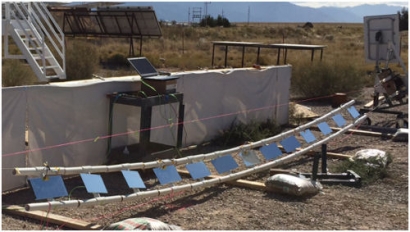
The mirrors, or heliostats, used in CSP technology reflect and concentrate sunlight onto receivers that collect the energy and convert it to heat. Typically they require a base, foundation, and motor which add to the total cost.
Skysun’s solar collector groups together heliostats through shared motors and support structures, which has the potential to substantially cut the total installed cost of CSP systems. Previous heliostat concepts were unsuccessful as they were neither cost competitive nor viable.
SkySun partnered with Sandia National Laboratories through a $275,000 Small Business Vouchers project funded by the U.S. Department of Energy. Sandia believes that Skysun’s ganged heliostats can achieve an average price around $80 per square meter. That translates to 33% lower than the lowest average cost for today’s conventional heliostats ($120 per square meter).
In order to test the new technology, Skysun used a grant from Innovation Fund America to build its first lab-scale prototype, then worked with Sandia to model and optimize the system. Modeling on Skysun’s solar collectors show that its mirrors achieve CSP industry accuracy standards with winds up to 15-20 miles per hour.
Skysun founder Jim Clair believes he will be able to leverage the outcomes from Skysun’s collaboration with Sandia in his search for a strategic partnership to prepare this technology for market adoption. Describing Sandia as “the mecca for CSP,” Clair said Sandia’s support in demonstrating the ganged heliostat’s stability, performance, and cost will be instrumental in showing the technology’s viability to potential partners.
Learn more about the SunShot Initiative and Tech-to-Market program within DOE’s Office of Energy Efficiency and Renewable Energy.
Photo: Ganged heliostat prototype installed at Sandia National Laboratories' National Solar Thermal Test Facility. (Department of Energy)

